THE ANCIENT EGYPTIAN COLLECTION AT THE MUSEUM OF FINE ARTS, BOSTON. PART 2, A REVIEW OF FORMER TREATMENTS AT THE MFA AND THEIR CONSEQUENCES
SUSANNE G�NSICKE, PAMELA HATCHFIELD, ABIGAIL HYKIN, MARIE SVOBODA, & C. MEI-AN TSU
REFERENCES
Beale, A.1996. Understanding, restoring, and conserving ancient bronzes with the aid of science. In The fire of Hephaistos: Large classical bronzes from North American collections, ed. C.Mattusch. Cambridge, Mass.: Harvard University Art Museums. 65–80.
Beale, A.2002. Personal communication. Museum of Fine Arts, Boston.
Blanchette, R. A., J. E.Haight, R. J.Koestler, P. B.Hatchfield, and D.Arnold. 1994. Assessment of deterioration in archaeological wood from ancient Egypt. Journal of the American Institute for Conservation33:50–70.
Bolshakov, A.1991. What did the bust of Ankhhaf originally look like? Journal of the Museum of Fine Arts3:5–14.
Bothmer, B.1948. A wooden statue of Dynasty VI. Bulletin of the Museum of Fine Arts46:30–36.
Bothmer, B. V.1951. A hippopotamus statuette of the Middle Kingdom. Bulletin of the Museum of Fine Arts49:98–102.
D'Auria, S., P.Lacovara, and C. H.Roehrig. 1988. Mummies and magic: The funerary arts of ancient Egypt. Boston: Museum of Fine Arts.
Dunham, D.1927. Letter to J. L. Smith, September 16. Museum of Fine Arts, Boston.
Dunham, D.1928. Letter to G. A. Reisner, February 22. Museum of Fine Arts, Boston.
Dunham, D.1931. An Egyptian bronze aegis. Bulletin of the Museum of Fine Arts29:104–9.
Dunham, D.1935. Successive installations of a statue of King Mycerinus. Bulletin of the Museum of Fine Arts33:22–25.
Dunham, D.1950. The royal cemeteries of Kush I: El Kurru. Cambridge, Mass.: Harvard University Press.
Dunham, D.1958. Two pieces of furniture from the Egyptian Sudan. Bulletin of the Museum of Fine Arts46:98–101.
Dunham, D., and W. K.Simpson. 1974. The mastabas of Queen Mersyankh III. Boston: Museum of Fine Arts.
Eaton, E. S.1941. A group of Middle Kingdom jewelry. Bulletin of the Museum of Fine Arts39:94–98.
Fishman, R.1986. A technical and historical examination of traditional adhesive recipes. In Conservation training programs, student papers: Twelfth annual conference. New York: Conservation Center of the Institute of Fine Arts. 97–145.
Frantz, J. H., and D.Schorsch. 1990. Egyptian red gold. Archeomaterials4:133–52.
G�nsicke, S., P.Hatchfield, A.Hykin, M.Svoboda, and C.Mei-an Tsu. 2003. The Ancient Egyptian Collection at the Museum of Fine Arts, Boston. Part 1, A review of treatments in the field and their consequences. Journal of the American Institute for Conservation42(2):167–92.
G�nsicke, S., and J.Hirx, 1997. A translucent waxresin fill material for the compensation of losses in objects. Journal of the American Institute for Conservation36:17–29.
G�nsicke, S., and R.Newman. 2000. Gilded silver from ancient Nubia. In Gilded metals: History, technology and conservation, ed. T.Drayman-Weisser. London: Archetype. 73–96.
Gilberg, M.1987. Friedrich Rathgen: The father of modern archaeological conservation. Journal of the American Institute for Conservation26:105–20.
Griffith, F. L.1890. The antiquities of Tell el-Yahudiya. London: Kegan, Paul, Trench, Tr�bner and Co.
Hatchfield, P. B.1986. Note on a fill material for water-sensitive objects. Journal of the American Institute for Conservation25:93–96.
Hatchfield, P. B.1988. The use of cellulose ethers in the treatment of Egyptian polychromed wood. In Conservation of ancient Egyptian materials, ed. S. C.Watkins and C. E.Brown. London: Institute of Archaeology Publications, United Kingdom Institute for Conservation Archaeology Section. 71–78.
Hatchfield, P. B., and R. J.Koestler. 1987. Scanning electron microscopic examination of archaeological wood microstructure altered by conservation treatments. Scanning Microscopy1:1059–69.
Hiscox, G. D., ed.1907. Henley's 20th century book of recipes, formulas, and processes. New York: N.W. Henley Publishing Company.
IIC-AG. 1968. The Murray Pease report: Code of ethics for art conservators, articles of association of IIC, bylaws of the American Group. New York: International Institute for Conservation of Historic and Artistic Works. 58–89.
JaeschkeR., and H.Jaeschke. 1988. Early conservation techniques in the Petrie Museum. In Conservation of ancient Egyptian materials, ed. S. C.Watkins and C. E.Brown. London: Institute of Archaeology Publications, United Kingdom Institute for Conservation Archaeology Section. 17–23.
Lachevre, J. L.2002. Personal communication. Museum of Fine Arts, Boston.
Leveque, M.1987. An approach to the conservation of Egyptian mummies: The mummy of Lady Nesmutaatneru. In Recent advances in the conservation and analysis of artifacts, ed. J.Black. London: Summer Schools Press. 239–41.
Lucas, A.1927. Lucas on silver bracelets. Unpublished typescript. Museum of Fine Arts, Botson.
Lucas, A.1932. Antiques: Their restoration and preservation. 2d ed.rev. London: E. Arnold and Co.
Mangum, B. J.1986. On the choice of preconsolidant in the treatment of an Egyptian polychrome triad. In Case studies in the conservation of stone and wall paintings: Preprints of the contributions to the Bologna Congress, 21–26 September. London: International Institute for Conservation. 148–50.
MFA. 1944. Sixty-ninth annual report for the year 1944. Boston: Museum of Fine Arts.
Newman, R.1998. Technical report: Organic residues from Egyptian blue anhydrite duck flasks and other anhydrite vessels. Metropolitan Museum Journal33:49–53.
Newman, R., and M.Serpico. 2000. Adhesive and binders. In Ancient Egyptian materials and technologies, ed. P. T.Nicholson and I.Shaw. Cambridge: University Press. 475–94.
Nichols, M. E. n.d. Basic local electrolytic reduction of silver. Unpublished typescript. Museum of Fine Arts, Boston.
Norman, M.2002. Personal communication. Ashmolean Museum, Oxford, England.
Petrie, W. M. F.1892. Medum. London: D. Nutt.
Petrie, W. M. F.1904. Methods and aims in archaeology. London: Macmillan and Co.
Podany, J., M.Elston, L.Thoresen, and S. L.Maish. 1995. The use of paper pulp based fill material for compensation of losses to sculptures. In From marble to chocolate, ed. JackiHeumann. London: Archetype. 59–64.
Rathgen, F.1905. The preservation of antiquities: A handbook for curators. Cambridge: University Press.
Reisner, G. A.1923. Excavations at Kerma, part 4–5. Harvard African Studies 6. Cambridge, Mass.: Harvard University Press. 269, pl. 56, 2.
Reisner, G. A.1927. The tomb of Hetepheres. Bulletin of the Museum of Fine Arts, special number, supp. to vol. 25.
Reisner, G. A.1931. Mycerinus: The temples of the third pyramid at Giza. Cambridge, Mass.: Harvard University Press.
Schur, S. E.1977. Laboratory profile: The Boston Museum of Fine Arts' research laboratory. Technology and Conservation2(2):1–6.
Serpico, M.2000. Resins, amber and bitumen. In Ancient Egyptian materials and technologies, ed. P. T.Nicholson and I.Shaw. Cambridge: University Press. 430–74.
Serpico, M., and R.White. 2000. Oil, fat and wax. Ancient Egyptian materials and technologies, ed. P. T.Nicholson and I.Shaw. Cambridge: University Press. 390–429.
Thomas, N., ed.1995. The American discovery of ancient Egypt. New York: H. Abrams. 50–51.
Whitehill, W. M.1970. Museum of Fine Arts, Boston: A centennial history. Cambridge, Mass.: Belknap Press.
Young, W. J. n. d. Electrolytic treatment of ancient metals. Unpublished typescript. Museum of Fine Arts, Boston.
Young, W. J.1958. Examination of works of art embracing the various fields of science. In Application of science in examination of works of art. Boston: Museum of Fine Arts. 17–30.
Young, W. J.1963. Electrolytic cleaning of ancient metals. Unpublished typescript for the Encyclopedia of electrochemistry. Reinhold, New York.
AUTHOR INFORMATION
SUSANNE G�NSICKE received a certificate in archaeological conservation from the R�misch-Germanisches Zentralmuseum, Mainz, Germany, in 1987, followed by an advanced-level internship at the Museum of Fine Arts, Boston, and an Andrew W. Mellon Fellowship in objects conservation at the Metropolitan Museum of Art. She worked as site conservator at the New York University Apis Expedition at Memphis, Egypt, and at the MFA Expedition at Gebel Barkal, Karima, Sudan. Currently associate conservator of objects in the Department of Conservtion and Collections Management, she has been employed at the Museum of Fine Arts, Boston, since 1990. She has published and lectured widely on the technical study of ancient Egyptian and Nubian material culture and on issues of site preservation. Address: Objects Conservation, Museum of Fine Arts, Boston, 465 Huntington Ave., Boston, Mass. 02115
PAMELA HATCHFIELD is head of objects conservation at the Museum of Fine Arts, Boston, where she has been employed since 1985. She has a master's degree in art history and a certificate in conservation from New York University. She served an advanced-level internship at the Harvard University Art Museums and has worked and volunteered in conservation at numerous institutions including the Metropolitan Museum of Art, the Harvard University Art Museums, the Smithsonian's National Museum of Natural History, the Cooper-Hewitt National Design Museum, and the Grenada National Museum. She has also served as site conservator on the New York University Apis Expedition at Memphis, Egypt, and the Museum of Fine Arts, Boston, Expedition to the Western Cemetery at Giza. She has held numerous positions within AIC, including program chair and chair of the Objects Specialty Group, AIC Board member (director for public outreach), and chair of the Publications Committee. Under a Kress Publications Grant from AIC, she has recently authored Pollutants in the Museum Environment: Practical Strategies for Design, Exhibition and Storage. With Jane Carpenter, she published Formaldehyde: How Great Is the Danger to Museum Collections? Her research interests include the museum environment, the examination and treatment of archaeological wood, polychrome, and stone, and Egyptian gilding methods. Address as for G�nsicke
ABIGAIL HYKIN is associate conservator of objects in the Department of Conservation and Collections Management at the Museum of Fine Arts, Boston. She received her M.A. and certificate of advanced study in objects conservation from the State University College at Buffalo, New York, in 1992. She continued her training at the Asian Art Museum of San Francisco, the Center for Conservation and Technical Studies at the Fogg Art Museum, and the MFA. She was assistant conservator of decorative arts and sculpture at the J. Paul Getty Museum from 1995 to 2000. Address as for G�nsicke
MARIE SVOBODA is a graduate of the State University of New York, College at Buffalo, Art Conservation Program, receiving her M.A. and certificate of advanced study in 1994. Her postgraduate experience includes positions at the Museum of Fine Arts, Boston, the Smithsonian Center for Materials Research and Education, the J. Paul Getty Museum, and the Los Angeles County Museum of Art. Her interest and love for the conservation of archaeological material has led her to work at excavations in Turkey, Pakistan, and Honduras. As of 1997 she has been an assistant conservator at the Museum of Fine Arts, Boston. Address as for G�nsicke
C. MEI-AN TSU received her M.S. in objects conservation from the University of Delaware in 1995 and held conservation fellowships at the Freer Gallery of Art, Harvard University Art Museums, and Smithsonian Center for Materials Research and Education. She has worked as an archaeological conservator in Turkey, Israel, Honduras, and Pakistan and is currently involved in the preservation of cuneiform tablets in Turkey. Prior to becoming an assistant conservator at the Museum of Fine Arts, Boston, in 2000, she was a project coordinator and assistant conservator at the Isabella Stewart Gardner Museum. Address as for G�nsicke
APPENDIX
APPENDIX 1. SUMMARY OF MATERIALS THAT MAY HAVE BEEN USED FOR TREATING THE ANCIENT EGYPTIAN COLLECTION AT THE MUSEUM OF FINE ARTS, BOSTON
Table .
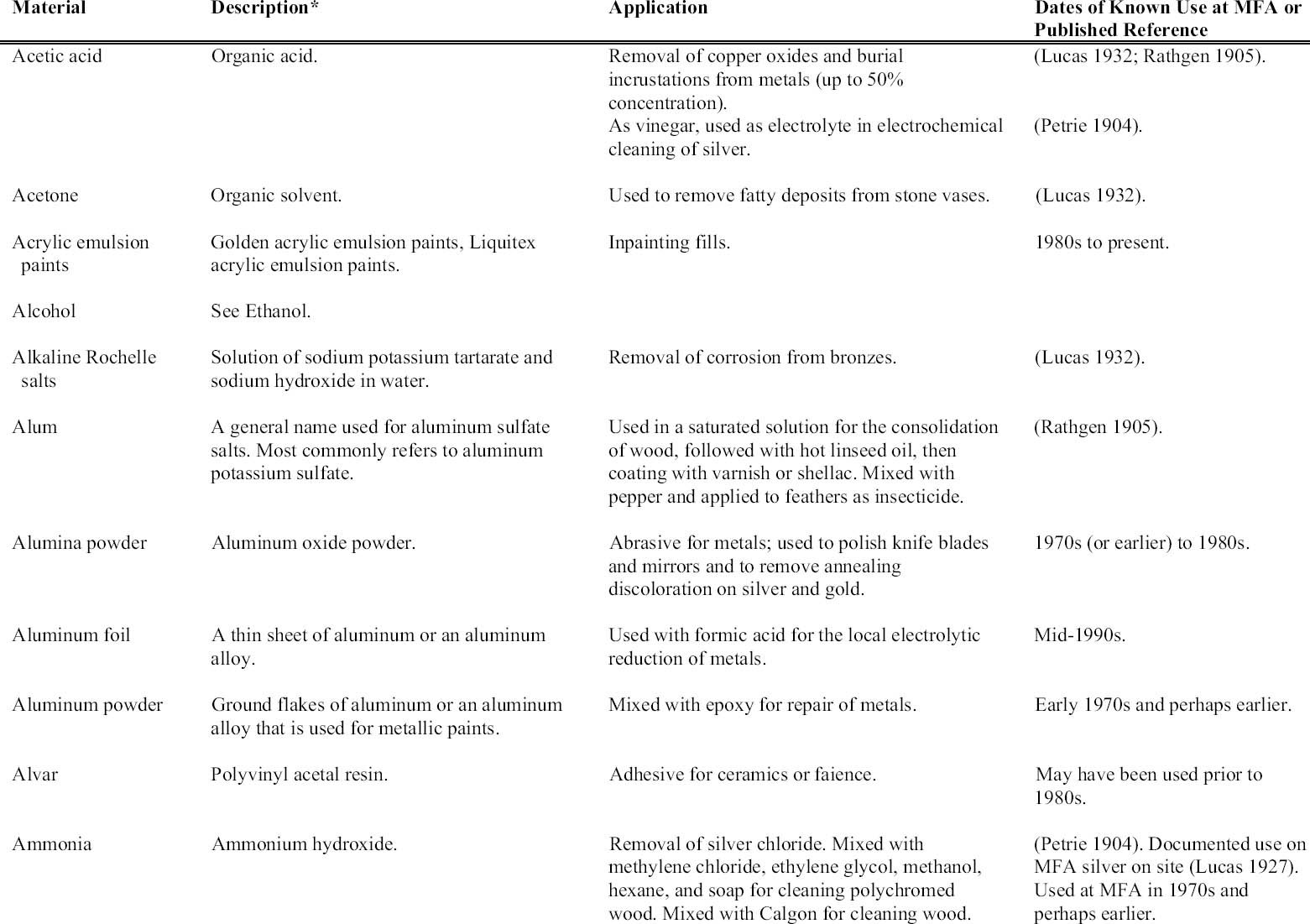 |
Table .
 |
Table .
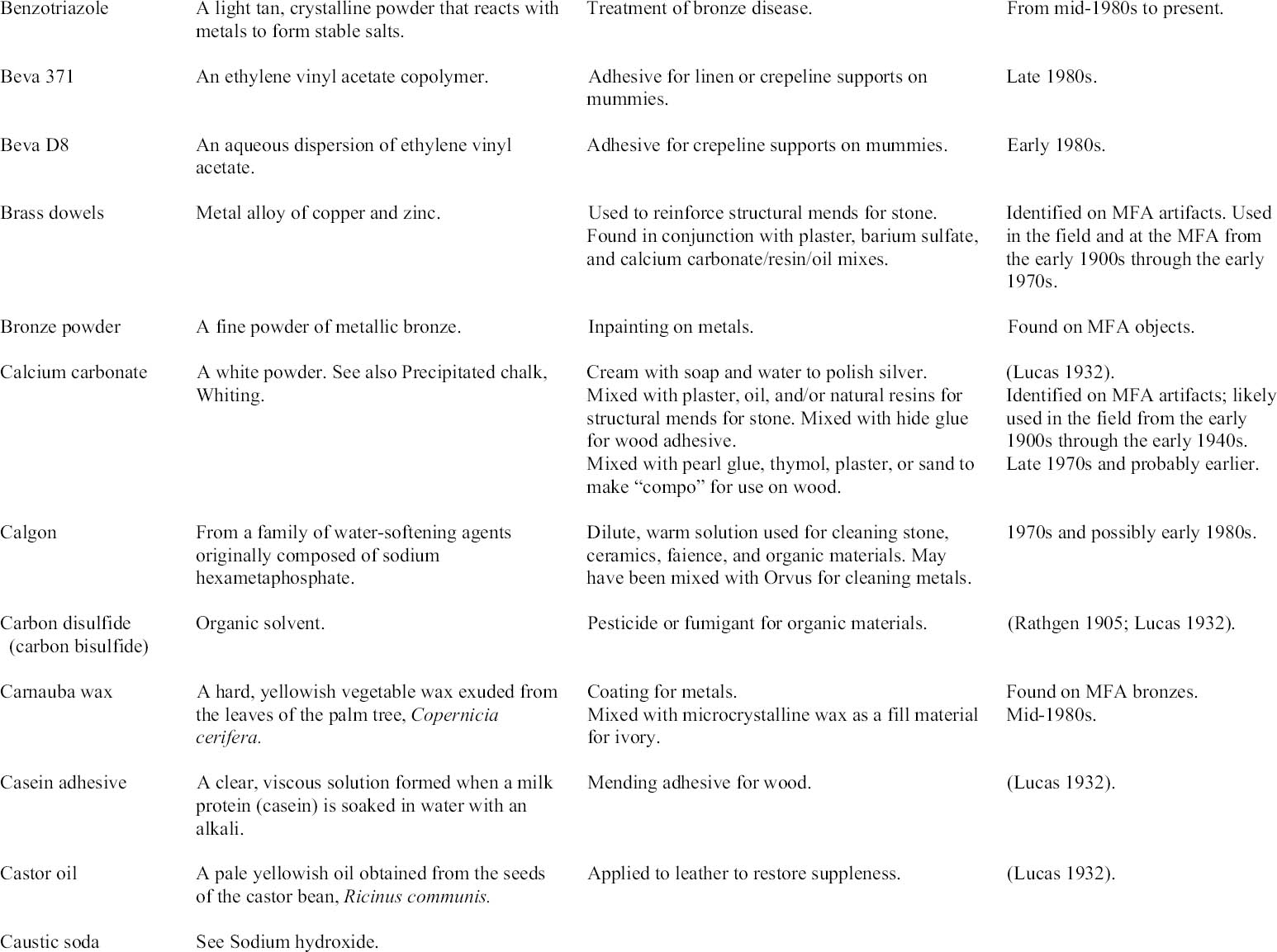 |
Table .
 |
Table .
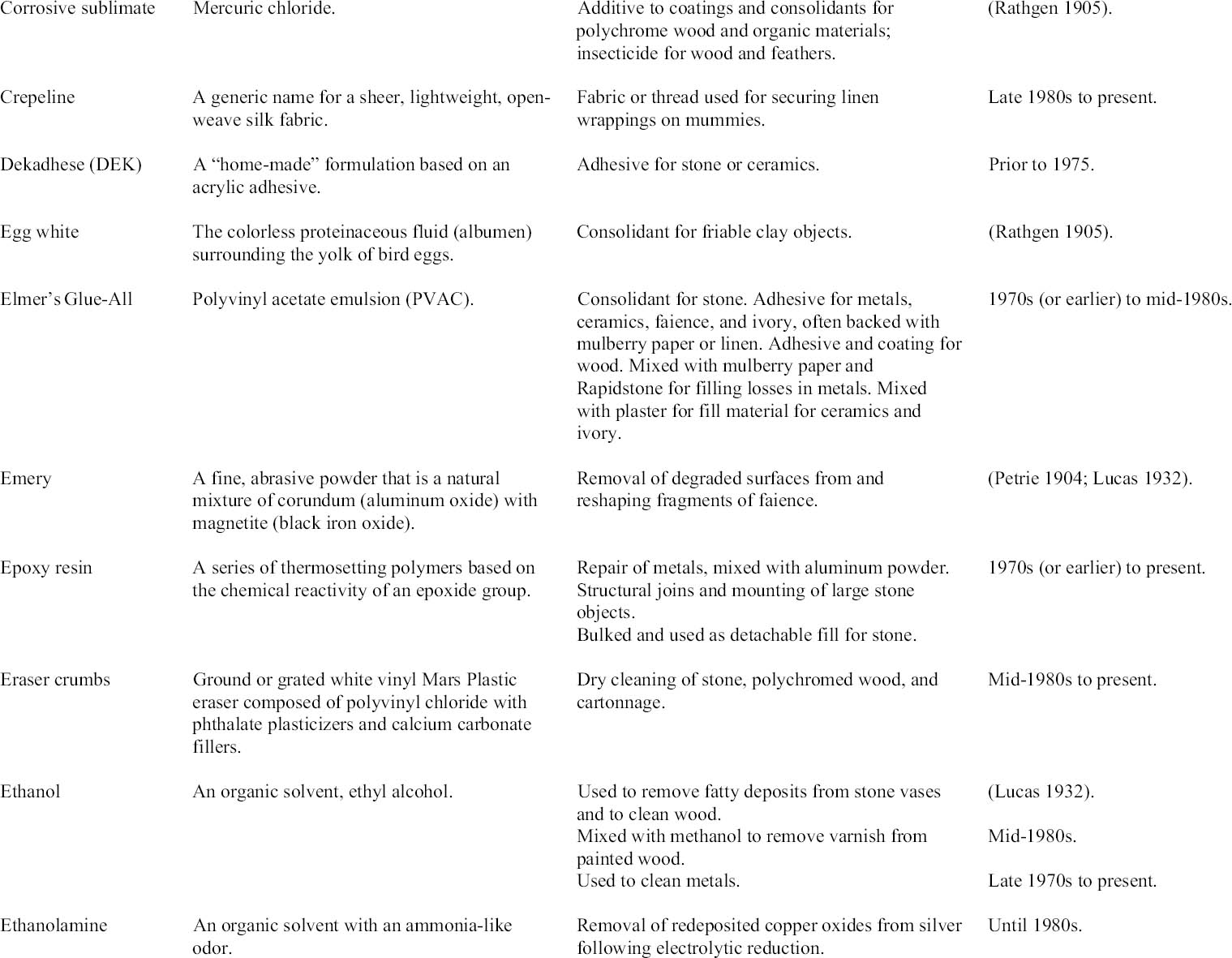 |
Table .
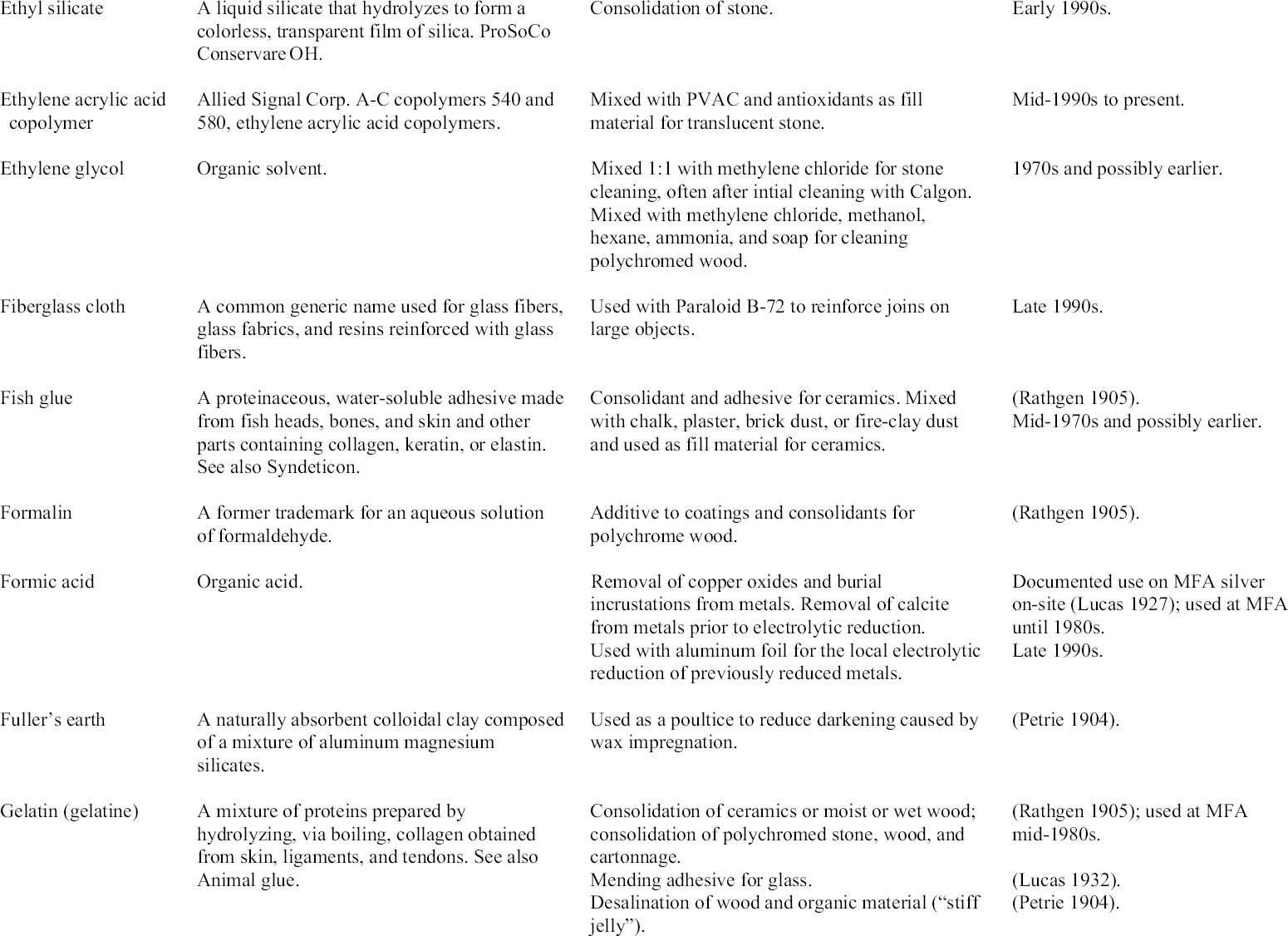 |
Table .
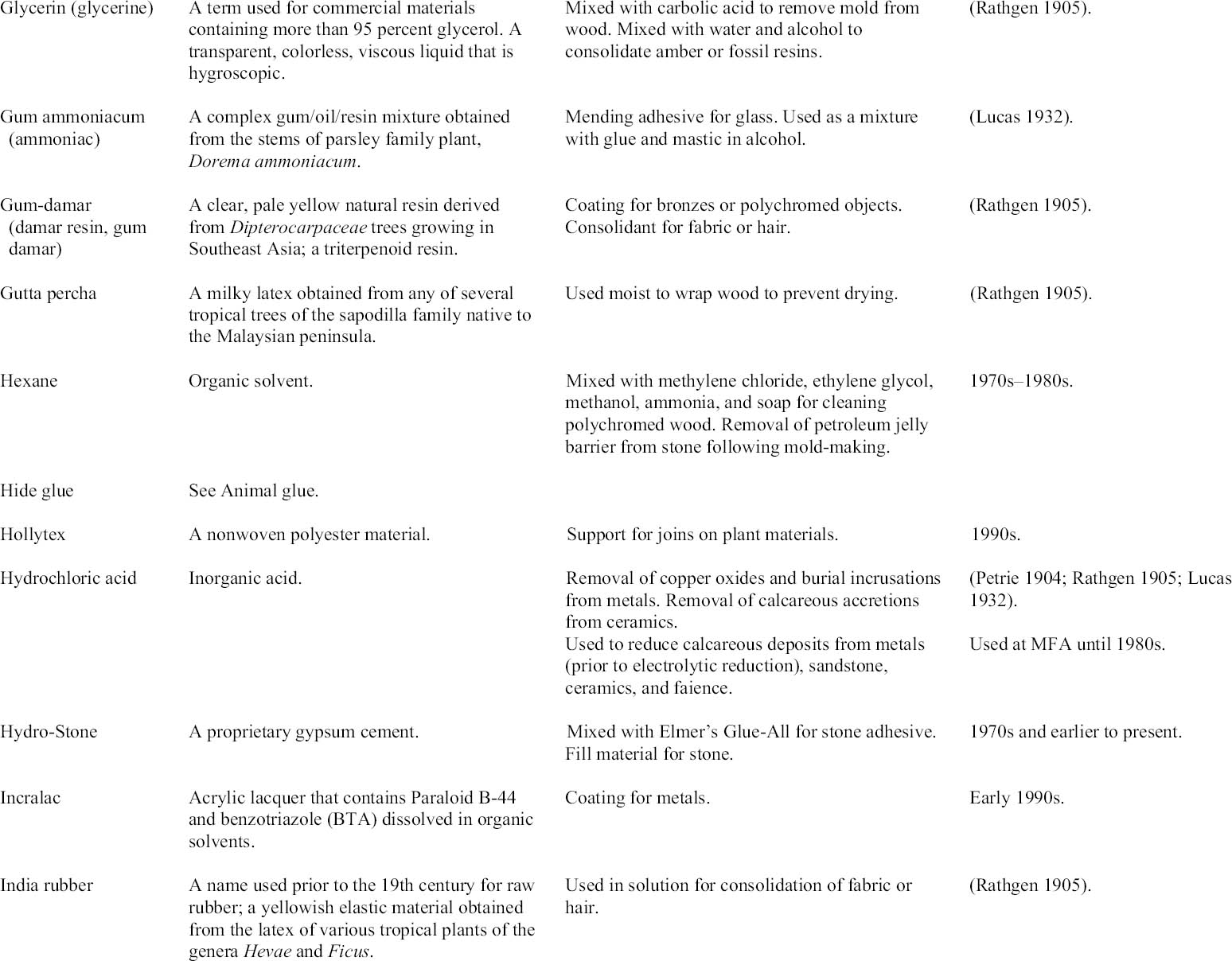 |
Table .
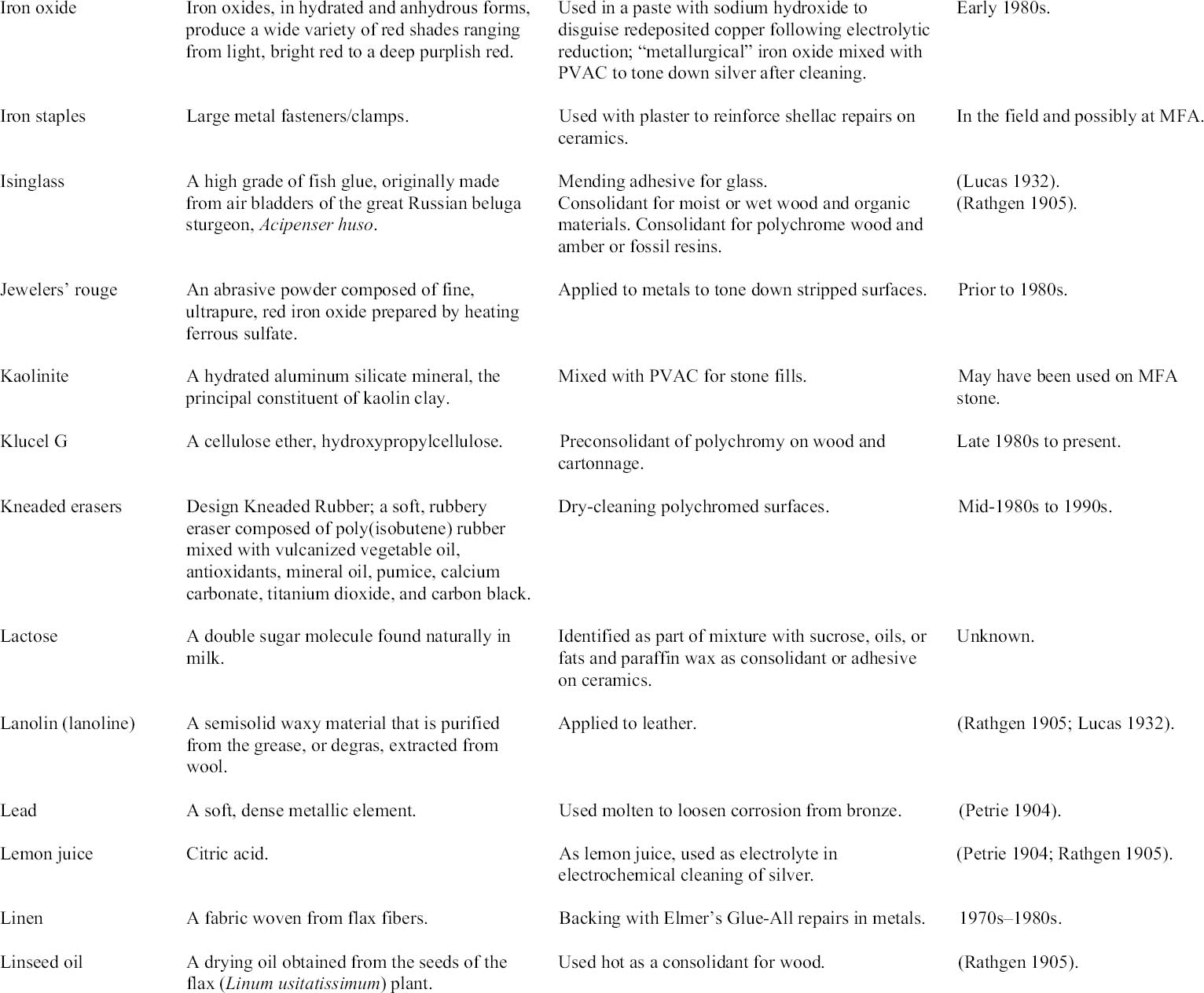 |
Table .
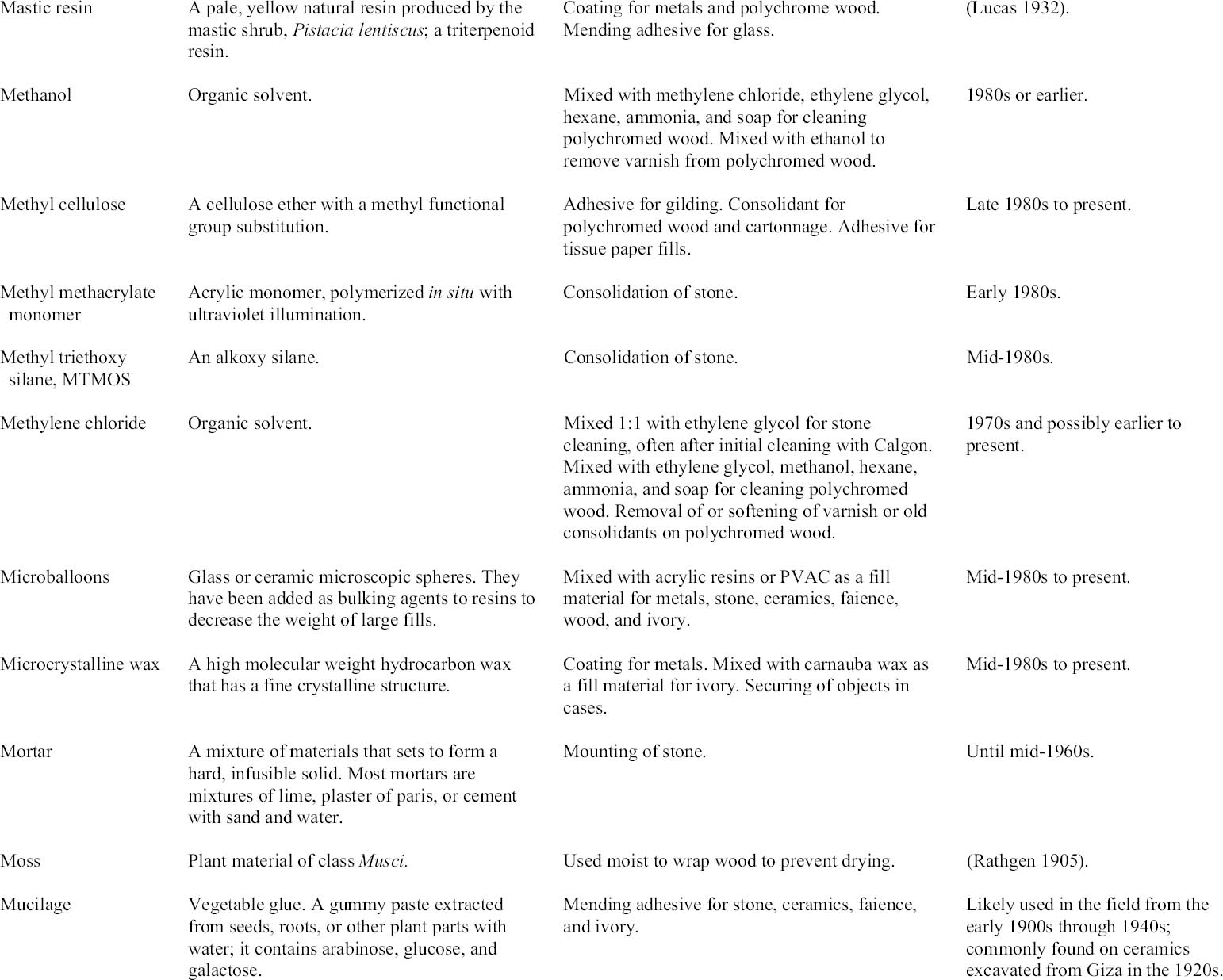 |
Table .
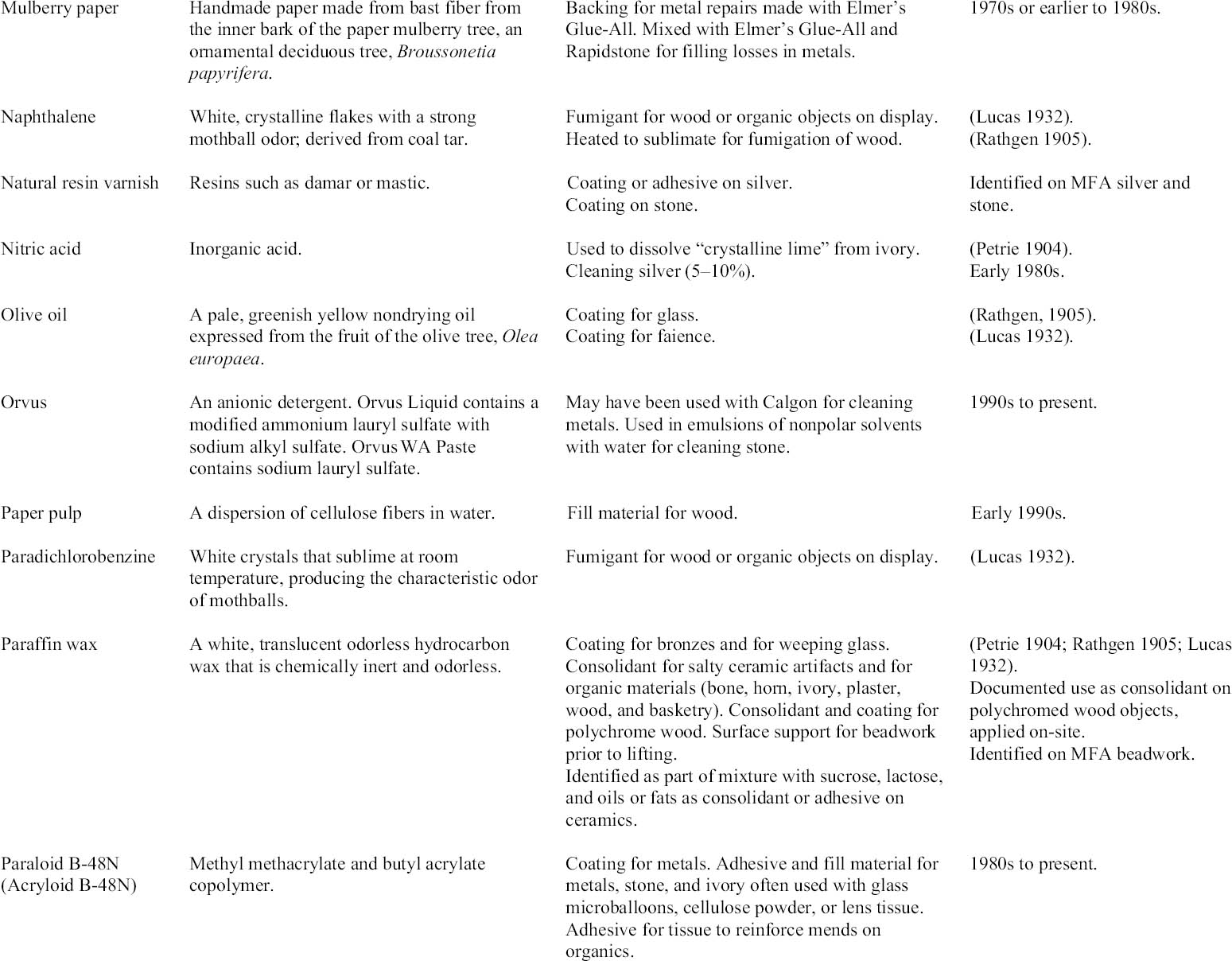 |
Table .
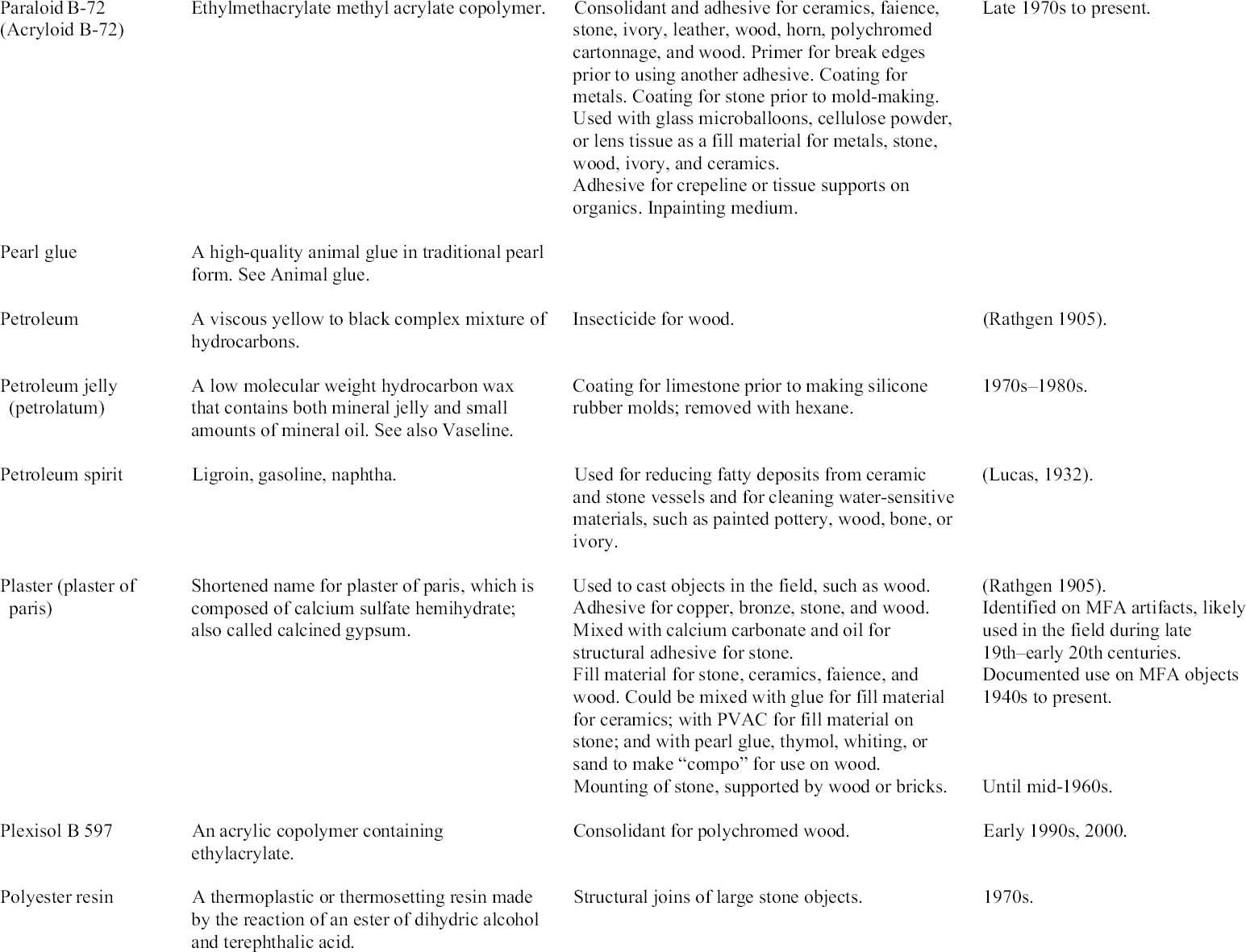 |
Table .
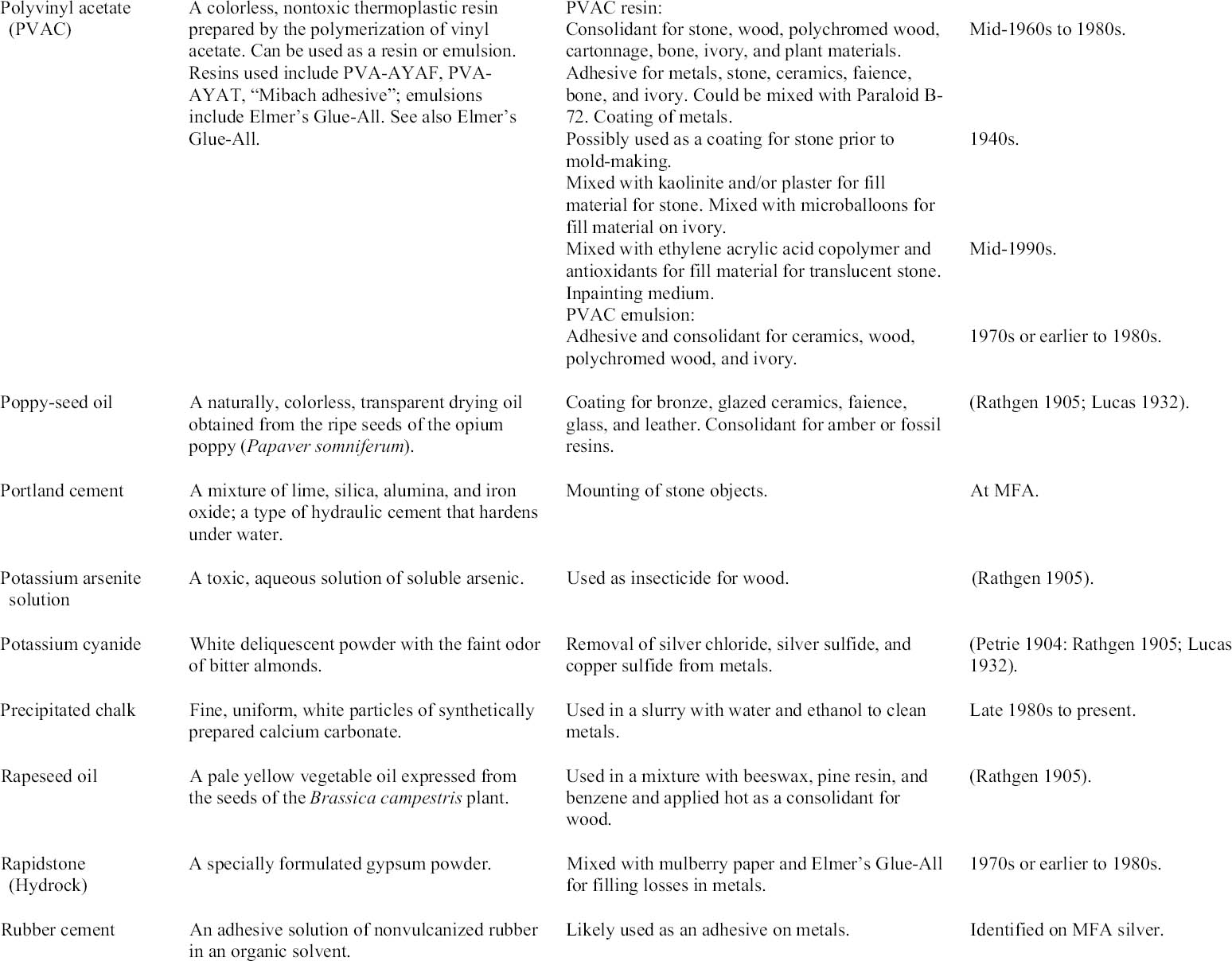 |
Table .
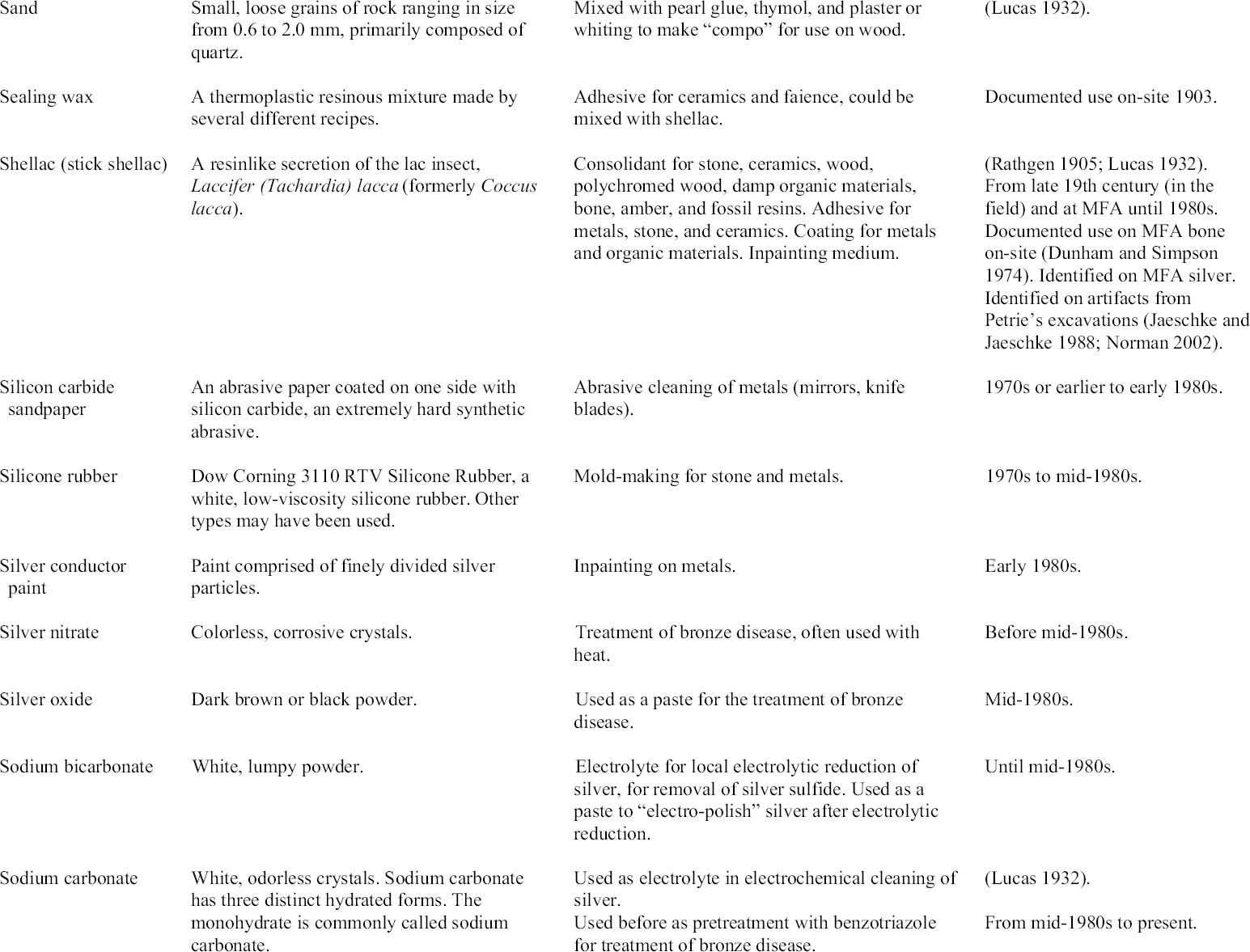 |
Table .
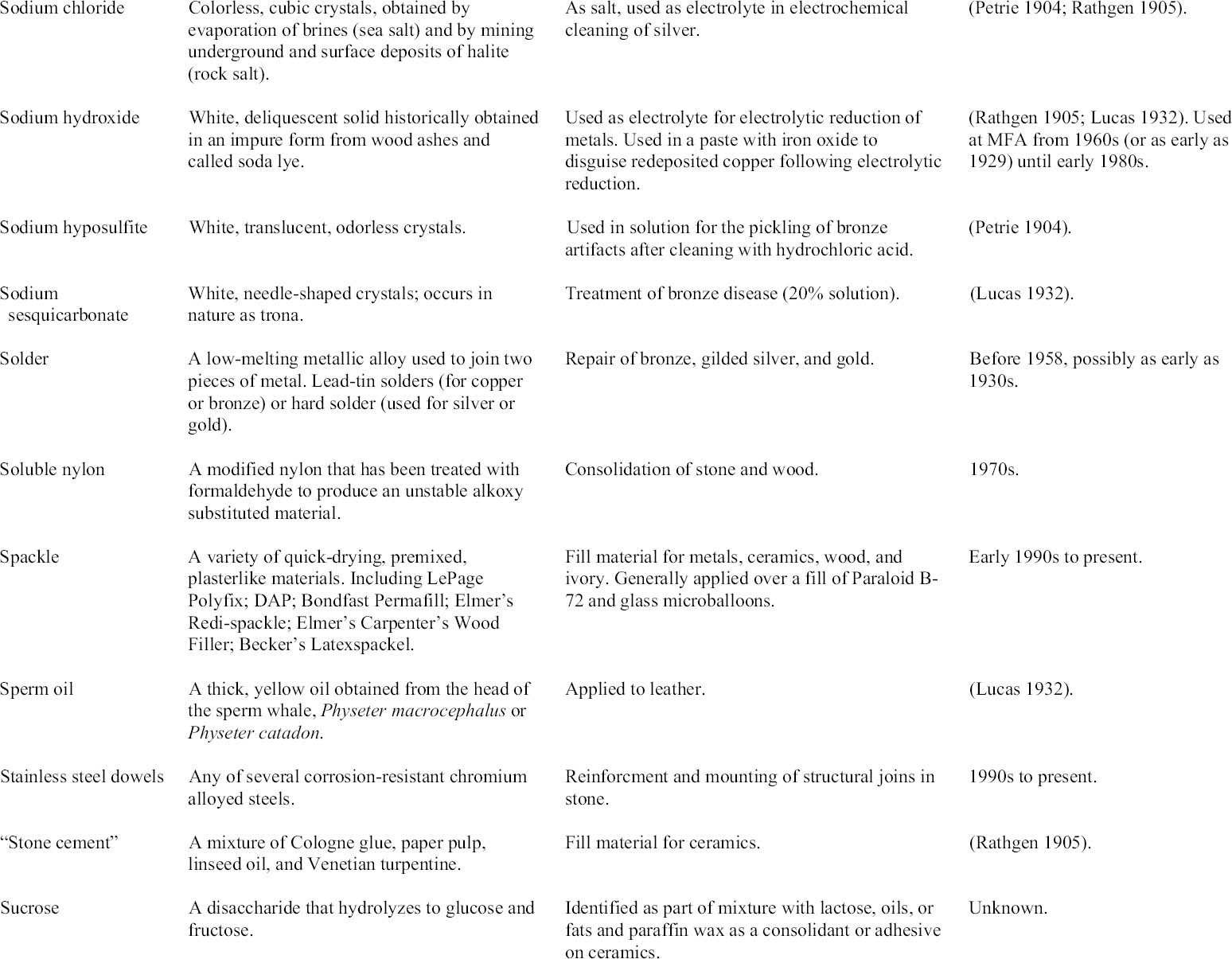 |
Table .
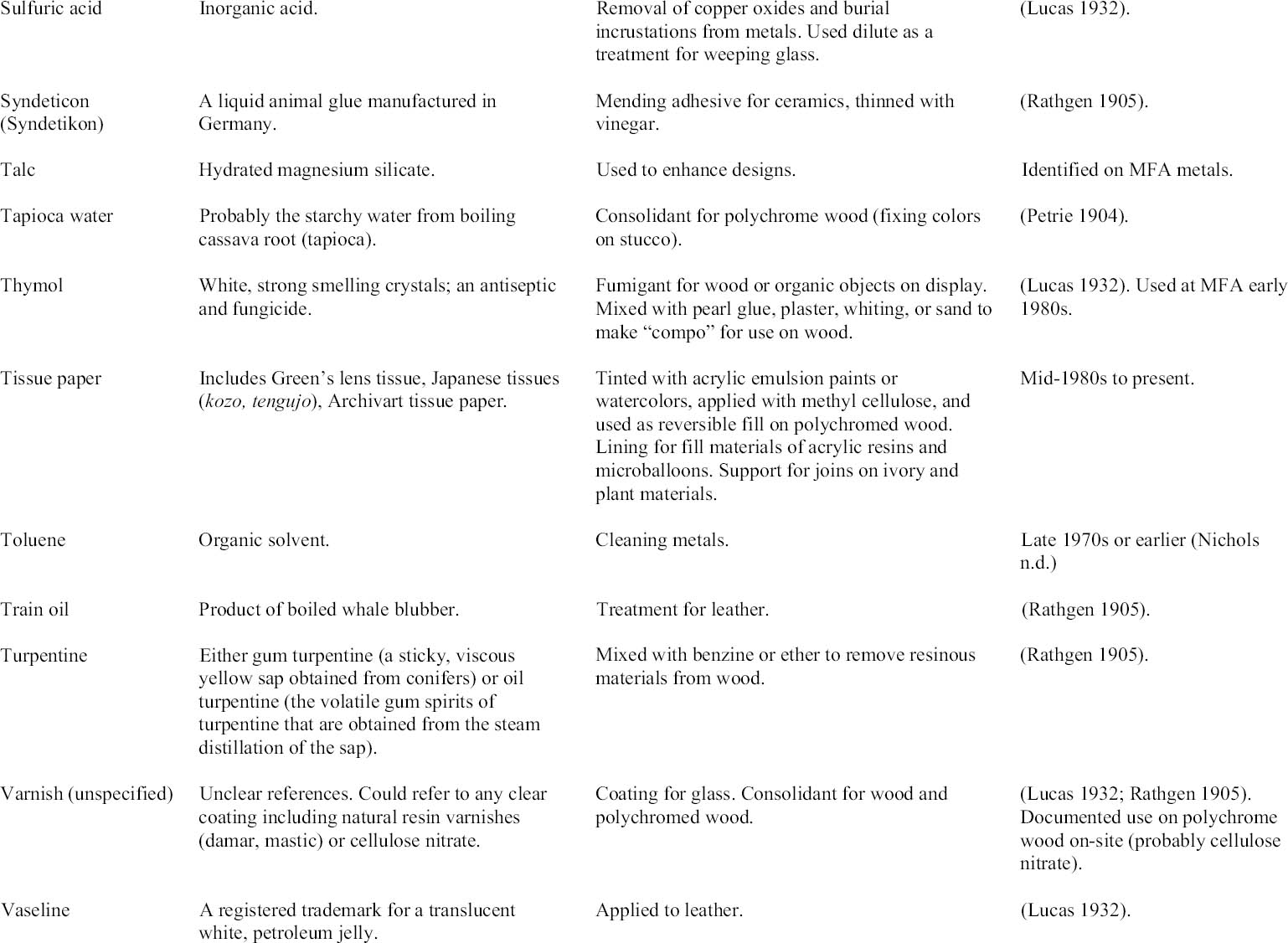 |
Table .
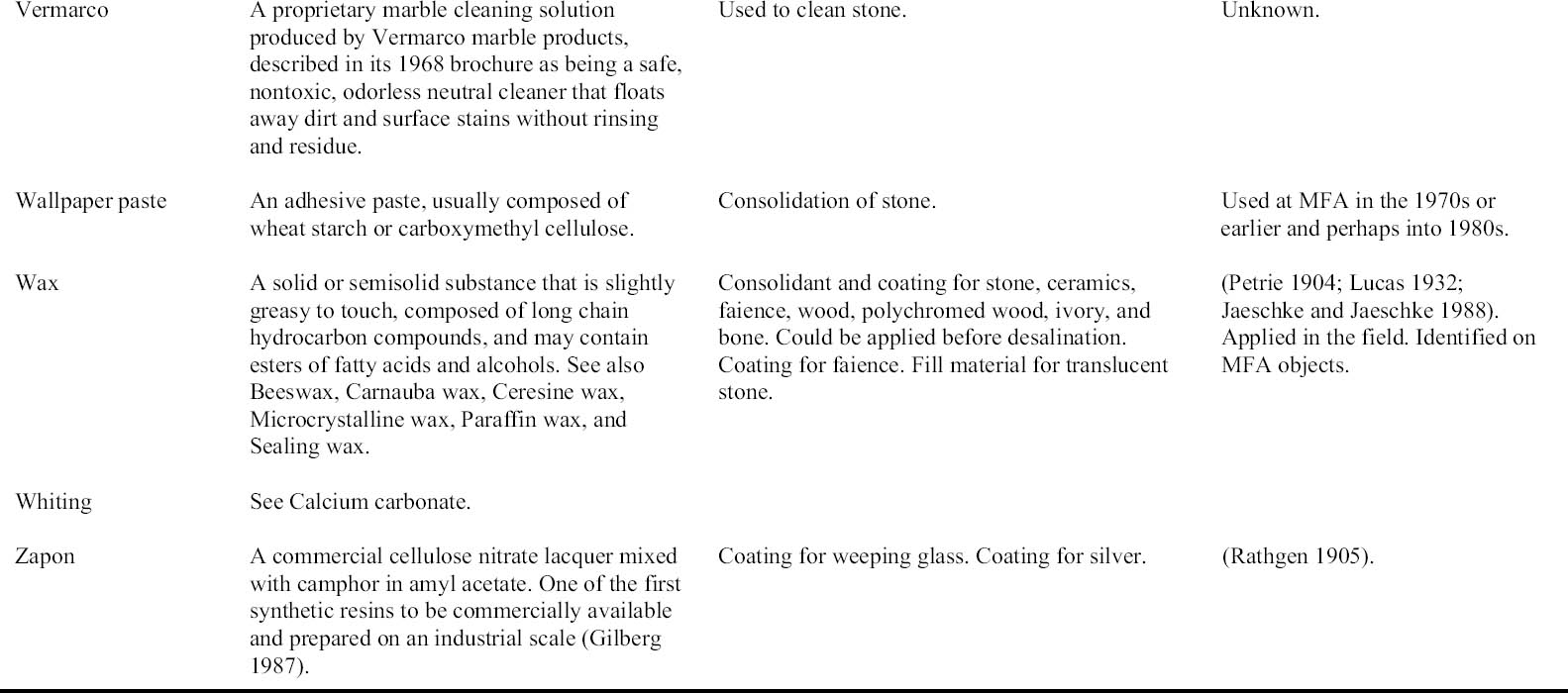 |
|